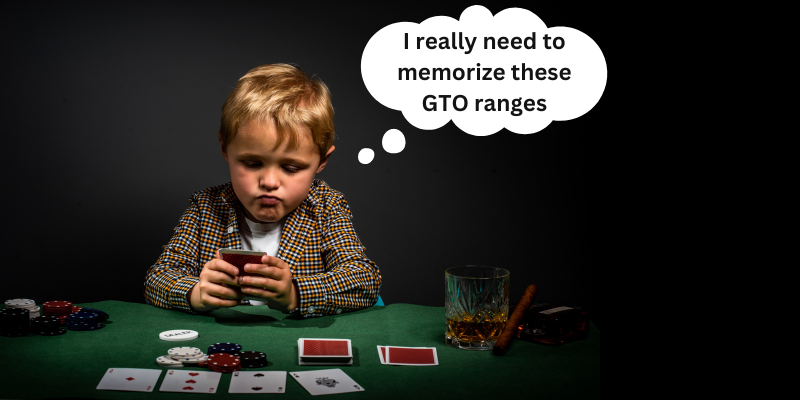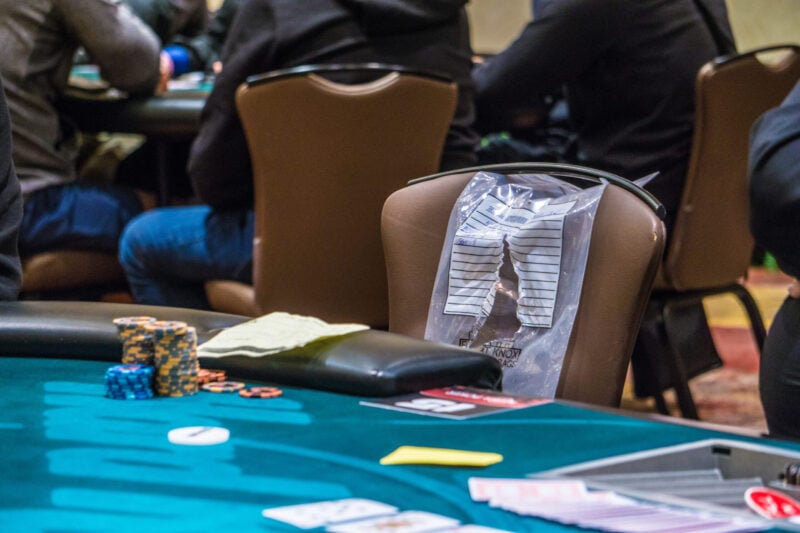If you’re one of those players who thinks GTO (Game Theory Optimal) play is boring, it’s time to change your thinking. While I would never tell you to play like a robot, having that arrow in your quiver is essential against great players. It takes away their skill advantage and also lets them know that you are not to be messed with so that (hopefully) they are less inclined to play hands with you.

Let’s start with a basic understanding of what I’m talking about here. I am not telling you to spend a thousand hours studying with a solver. That would not only be a lot of work, but it would probably take much of the fun out of the game for you. My goal here is just to help you play in a way that is harder for the pros to exploit.
At the end of part one I talked about hiding information from the pros and not revealing anything about your hand strength from your bet sizing. Let’s talk about some more ways to do that.
Finding (some) balance
The strategies we’re about to cover don’t give you a perfectly balanced “solver-approved” approach, but we’ll call them “semi-balanced” because they are much harder to exploit, especially over the small sample size of a live tournament.
Let’s assume that a strong pro raises from late position and you call to defend your big blind with twenty five big blinds in your stack. Let’s also assume the pro has you covered. On a flop of Ah7c6c, you check, because coming with a balanced lead range is way beyond the scope of this article.
When the pro bets, what should you do with the hands you want to play? We can find a few semi-balanced approaches here.
You can raise all-in with all your draws, sets, two pairs, and aces and fold everything else. This puts your opponent to a tough decision. Does he call with an ace? What if his kicker isn’t very good? Does he fold unless he has at least Ace-Queen and let you semi-bluff him with all of your draws? Or does he pay you off and get it in slightly ahead of your draws and way behind your sets and two pairs?
You could also raise all-in with your draws and two-pair hands and call with one pair or a set. This approach is also semi-balanced and lowers your variance a bit because you don’t have to go all-in with your draws. It may be a bit easier for your opponent simply because you are allowing them to determine what happens on the turn in some cases, but it’s not a bad way to play if you are nearing the bubble and don’t want to go broke with one pair.
Either way, it’s important that you have some very strong hands in your checking range or the pro will always bet the flop and the turn and force you to fold whenever you don’t raise him on the flop. The key is to make sure they can’t simply put you on the top or bottom portion of your range based on your betting pattern or bet sizing.
Which strategy you choose is not nearly as important as avoiding the bad strategies that the pro will attack. If you raise all-in with your draws and call with your big hands, or vice-versa, it won’t take long for a strong player to spot what you are doing. And trying to switch up your strategies is likely to leave you a step behind the pro, no matter how clever you think you are.
Range vs. range
Another way to stay balanced is to remember that certain unavoidable behaviors are going to tip off your hand range and not allow your opponent to use that information against you so easily. Let’s look at an example of that where many amateurs get in trouble.

You raise from early position and an aggressive pro calls to defend his big blind. He knows that you have a reasonable hand since you raised from early position. There is no way to completely avoid this, though raising a few hands that can hit low card boards, like Ace-Five suited and small pairs can help.
The flop is 5h7d8d. The pro checks to you. This board is much more likely to hit the range of hands that he defends his big blind with than your early position raising range. It is very likely that all you have is two over cards and he knows it. If you bet, can you call a big check-raise? Most of your range can’t stand a reraise and you don’t want to be playing a huge pot with a weak hand.
His strategy against a typical recreational player is to check-raise very frequently and win a lot of pots without a showdown. To foil this strategy you shouldn’t be making a continuation bet on boards that are much better for his range than for yours. This means checking back on coordinated boards with small cards like our example.
If you have an over pair, this strategy allows you to keep the pot a reasonable size with just one pair, and if you have two over cards it gives you a free shot at hitting one of them on the turn. It also gives you the opportunity to raise the turn with your big hands or as a semi bluff if you pick up a draw of some kind.
The key here is knowing that your opponent knows something about your hand range. And a good player will always know at least a little something about your hand range. Don’t play in a way that allows them to use this knowledge against you and steal pots from you easily.
You can also use their strategy yourself. If you are playing with a weaker player who doesn’t understand this spot, you can frequently steal pots from them. Picture the reverse situation. Now you are in the big blind and a weak player raises from early position. You call to defend your big blind with 7s5s.
When the flop is Ts4c4d, who is more likely to have a big hand here? It’s you! An early position raising range almost never hits this flop hard. A pair of tens is the only monster he is likely to have here, and A4s is possible but also not very likely. He probably just has two over cards and sometimes will have an over pair, but neither of those hands can stand a lot of heat from the big blind on this board.
If you check-raise, your opponent will usually just fold. If they have an over pair, they will often call, and if stacks are deep enough you can put them to the test. Do they want to put it all-in with two queens on a board like this when you are clearly indicating that you have flopped trips?
Now think about how much harder it will be to steal this pot if they check back on the flop. If you bet out, they can call down with any one-pair hand and may raise you if they don’t have a pair, forcing you to fold the vast majority of your range. If you check again and try to check-raise the turn, they may check behind again. It is much harder to steal the pot now that your opponent has chosen to keep it small and they will usually get to showdown with a winning hand.
Using the hammer
Remember, pros don’t usually like to call all-in bets without a real hand. They often don’t mind shoving all-in themselves with a weaker holding, but they don’t like to call it off. You can use this to your advantage by planning out the hand so that you have the chance to put in the last chip with a big enough bet to put them to the test.

Knowing how to use the all-in hammer, and preventing your opponents from doing so, will make life hard for the pros at your table. And it all starts with thinking forward through the hand and knowing the stack sizes and pot size.
Let’s go through a hand to illustrate this idea.
You raise from late position and a strong pro reraises from the small blind. You have fifty-five big blinds and Ace-Queen of diamonds, and his three-bet is small, so you call. The flop is 6d7d7c, giving you two over cards and a flush draw. There are thirteen big blinds in the pot and you each have around forty-nine big blinds in your stacks. The pro, in the small blind, is first to act and bets four big blinds.
If you make a reasonable sized raise, to say twelve big blinds, your opponent could go all-in for just the right size to make your decision a tough one. Do you want to call off your whole stack to try to win this pot with a draw, or abandon almost a quarter of your stack when you have a fairly strong hand?
The twelve big blind raise essentially handed the hammer to your opponent, giving him a chance to put the last chip in the pot while also putting enough heat on you to make for a tough decision. This isn’t good. You want the hammer in your hand in this spot, but the pot is too small to go all-in over his small flop bet.
Instead, if you call his bet, he is the one facing a tough decision on the turn. Does he bet again and risk you going all-in? Or does he check and maybe allow you to take your draw for free or steal the pot from him? If he bets, you can go all-in because there will be enough money in the pot and enough left behind in your stack to make his life hard.
Now consider a different bet size or stack size. If he had bet ten big blinds into the thirteen big blind pot, it would be a perfect spot for you to go all-in and put him to a tough decision. This is exactly why he didn’t bet big on this flop.
Thinking all the way through the hand, and not offering your opponent a spot where he can use the hammer, makes this hand much easier to play. And you should be doing this with your bet sizing and choice of when, or whether, to bet, every hand and on every street. Don’t give them the chance to use the hammer.
Remember, this choice doesn’t have to reveal anything about your hand. You are making the right play here whether you have a monster or a draw or a weak made hand, because it reveals nothing and puts your opponent in a tough spot.
Unless you want them to swing the hammer
If you are a recreational player, the pros will usually know it. We watch for these things. You didn’t show up with a backpack and comfortable shorts and a hoodie with earbuds and you didn’t say hello to a bunch of other pros on your way to the table, so we know you probably aren’t a professional tournament grinder. You can use this to your advantage as well. Because when you give a pro the chance to use the hammer, they won’t expect that you are setting them up.
In the scenario above, if you had flopped a full house, you could make a very small raise, as if you are trying to find out if your pair of nines is ahead. Or you could just call the flop and the turn, indicating the same thing. Recreational players often make this mistake with a mediocre hand, and the pro will assume you are doing just that. Whichever choice you make, if you give them a chance to go all-in and put the heat on you, they will usually take it, so you should only do this if you really want them to swing that all-in hammer.


